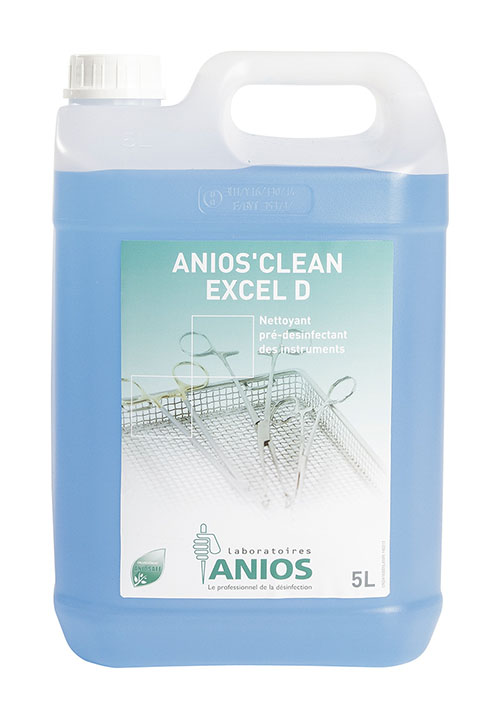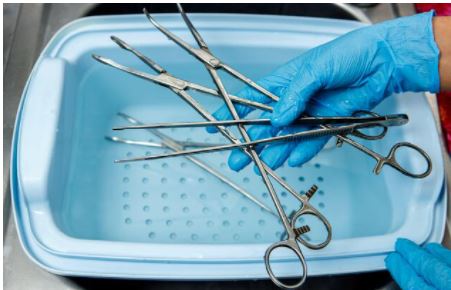DETERGENT/DISINFECTANT for MD, 5l tin + dosing pump
Valid Article
DETERGENT/DISINFECTANT for MD
Definition
One-step detergent-disinfectant product for the cleaning and pre-disinfection by immersion of medical equipment. A non-sterile liquid with a neutral pH intended to be applied to soiled medical, dental, and/or surgical instruments as part of the pre-cleaning and/or cleaning/disinfection process to remove blood proteins and other organic compounds prior to sterilization.
This solution must be diluted prior to use according to the manufacturer's instructions.
Specifications
Composition:
detergent active principles
antimicrobial active principles
- quaternary ammonium of the fourth generation (or higher) such as DDAC = Didecyldimethylammonium chloride or another equivalent biocidal product such as DDA = Dodecylamine = laurylamine
- combined with another disinfectant: biguanide derivative, isopropanol, alkylamine, amino acid, ethanol, ..
Quality Standards Comment
The standard European approach for disinfectant validation is divided up into three phases:
- Phase 1: Basic Suspension Tests for fungicidal and bactericidal activity
- Phase 2
- Step 1: Suspension and surface tests to evaluate the activity of a disinfectant against a range of microorganisms under conditions which more closely simulate practical use.
- Step 2: Surface test (= carrier test): surface samples are inoculated with a selection of microbial challenge organisms. A disinfectant is applied to the inoculated surfaces and exposed for a predetermined contact time.
- Phase 3: Field Trial
Applicable standards for the antimicrobial activity
- EN 1275: 2006: Chemical disinfectants and antiseptics - Quantitative suspension test for the evaluation of basic fungicidal or basic yeasticidal activity of chemical disinfectants and antiseptics - Test method and requirements (phase 1)
- EN 1040: 2006 : Chemical disinfectants and antiseptics - Quantitative suspension test for the evaluation of bactericidal activity of chemical disinfectants and antiseptics – Test method and requirements (phase1)
- EN 13727+A2: 2015: Chemical disinfectants and antiseptics - Quantitative suspension test for the evaluation of bactericidal activity in the medical area - Test method and requirements (phase 2, step 1)
- EN 14561: 2006: Chemical disinfectants and antiseptics. Quantitative carrier test for the evaluation of bactericidal activity for instruments used in the medical area. Test method and requirements (phase 2, step 2)
- EN 13624: 2013: Chemical disinfectants and antiseptics. Quantitative suspension test for the evaluation of fungicidal or yeasticidal activity in the medical area. Test method and requirements (phase 2, step 1)
- EN14562: 2006: Chemical disinfectants and antiseptics. Quantitative carrier test for the evaluation of fungicidal or yeasticidal activity for instruments used in the medical area. Test method and requirements (phase 2, step 2)
Regulatory
The combined detergent / disinfectant for medical devices has a dual status: biocide (group I PT2) and medical device (Class IIb) and must comply with both regulations:
- BPR = Biocidal Product Regulation: Regulation EU n° 528/2012 concerning the making available on the market and use of biocidal products
- MDR: Regulation EU n° 2020/561 on medical devices (amending Regulation EU n° 2017/745 about the dates of application of certain of its provisions)
Technical specifications
General characteristics
- Neutral or near-neutral pH detergent solution: they generally provide the best material compatibility profile and good soil removal.
- The product may contain enzymes.
- Nontoxic: it is not irritating to the skin or mucous membranes of the user
- Non-abrasive: to avoid damaging the delicate instruments
- Low-foaming: protection of the workers
- Good rinsability
- Easily soluble in water (lukewarm and cold), drinking water can be used for the dilution
- Removes dirt, soil, and various organic substances.
- Proven compatible with common equipment.
- Stable in concentrated and use dilution.
Microbiological spectrum
Detergent / disinfectant with standard activity at the defined use concentration & contact time (0.5% / 15 minutes). Tested in dirty conditions according the European standard for activity against:
- Bacteria (mandatory test organisms): E. Hirae, E. Coli, P. Aeruginosa, S. Aureus
- Candida albicans
- Enveloped viruses such as HBV, HCV, HIV and influenza virus
Label: according the BPR
- Hazard statement pictograms are correct
- Language of the label
- No misleading text in respect of the risks to health or environment
- Identification of every active substance and its concentration in metric units
- Directions for use and for safe disposal
- Batch number / expiry date clearly written
- Storage conditions written
Packaging & Labelling
- Tin of 5 litres with 25 ml dosing pump for each tin
- Packing group: III
- Proper shipping name: Environmentally hazardous substance, liquid, n.o.s
Instructions for use
Use disinfectants with care. Always read the label and product information before use. Preparation of cleaning and disinfection baths is done according to the IFU of the cleaning agent manufacturer. Water quality used for each step is as recommended per IFU (water hardness, pH, temperature).
For the selected product(s): the solution must be diluted at 0.5% to be ready for use: 25 ml = 1 stroke of dosing pump for 5 litres water (put the product in the water and not the other way around).
The solution should not be kept for more than 24h and renewed immediately if visibly contaminated: when it becomes blurred or with dirty things at the bottom of the bucket. The containers used for disinfection must be washed, rinsed and dried when the solution is changed.
Brushes, single-use cloth and other cleaning accessories are as recommended by the MD Manufacturer's IFU or equivalent brushes (usually soft nylon bristle brushes). Unless clearly specified in an MD IFU, metallic brushes are not used.
After disassembly according to the MD manufacturer IFU, if needed, steps are as follows:
- The MD is completely immersed in the bath. Articulated MD are open to minimize obscured surface area. Bubbles trapped in cavities and channels are eliminated. MD remains immersed during cleaning. Cleaning operations are performed in a manner that limits production of aerosols or dispersion of potential contaminated chemicals or water.
- Gross soil is removed. Accessible surfaces are cleaned with appropriate tools until visibly cleaned. MD's with articulations are moved (open and close at least 5 times). Channels are brushed. Brushing is always performed in the same direction from the less soiled to the most soiled end (at least 5 times). It must be checked that internal lumen and cavities are completely perfused and in contact with solution.
- MD is rinsed after the contact time has elapsed (recommended contact time = 15 minutes, use a timer) with appropriate water quality: 10 s at least for all external surfaces and 10 s flush for each channel.
- Dry the equipment with clean, lint-free cloth (to prevent dilution of the disinfectant of second bath)
- Repeat the same steps in a second bath.
- Visually inspect all equipment/devices once the cleaning process has been completed and prior to terminal disinfection/sterilization to ensure cleanliness and integrity of the equipment/device (e.g. cracks, defects, adhesive failures). Repeat the cleaning on any item that is not clean. Instruments with coagulation residues that cannot be removed even by intensive cleaning must be discarded, because their proper functioning and their required sterile condition can no longer be guaranteed.
- Follow the manufacturer's guidelines for lubrication.
- Do not reassemble equipment/device prior to disinfection/sterilization.
Precautions for Use
Always read the label and product information before use. Prepare use-solution according instructions. Pay attention to the quality of water needed.
Do not use for the skin disinfection.
Do not mix with other products.
If solutions are used for too long, there is a risk of corrosion due to contamination levels and to increased concentration of cleaning/disinfecting solution (because of evaporation), and the risk of insufficient disinfection due to accumulated contamination (loss of active agent/protein interference).
Hazardous product: Check the SDS (Safety Data Sheet) information supplied with the product as the information may differ according to the manufacturer!
Causes skin irritation and serious eye damage
Wear protective gloves/protective clothing/eye protection/face protection
In case of contact:
- IF SWALLOWED: rinse mouth. Do NOT induce vomiting
- IF ON SKIN (or hair): Remove/Take off immediately all contaminated clothing.
- IF IN EYES: rinse cautiously with water for several minutes. If the victim wears contact lenses, remove them if possible. Keep rinsing
Storage
Check the instructions from the manufacture
- Between 5 and 35ºC, in a dry and well ventilated place
- Shelf life: 3 years
- Discard the solutions after use
Transport Dangerous Goods
check the UN code for transport on the SDS
Waste management
- Avoid release to the environment: very toxic to aquatic life with long lasting effects
- Collect spillage
- Dispose of contents/container to location in accordance with local and regional/ national/ international regulations






![[KMEDMSTE9D-] (module central sterilization 90 l) DISINFECTION, RTR](/web/image/product.template/569140/image_256/%5BKMEDMSTE9D-%5D%20%28module%20central%20sterilization%2090%20l%29%20DISINFECTION%2C%20RTR?unique=f6a65ab)
![[KMEDMNUTI36D] (module nut. inpatient) MEDICINES, RTR 2021](/web/image/product.template/575124/image_256/%5BKMEDMNUTI36D%5D%20%28module%20nut.%20inpatient%29%20MEDICINES%2C%20RTR%202021?unique=8b13f4c)
![[KMEDMSTE3D-] (module central sterilization 39 l) DISINFECTION, RTR](/web/image/product.template/569146/image_256/%5BKMEDMSTE3D-%5D%20%28module%20central%20sterilization%2039%20l%29%20DISINFECTION%2C%20RTR?unique=63481ed)
![[ELINAPRP1P-] APRON PROTECTION, PVC, reusable](/web/image/product.template/572318/image_256/%5BELINAPRP1P-%5D%20APRON%20PROTECTION%2C%20PVC%2C%20reusable?unique=b82bf39)
![[ELINFSSHR01] FACE SPLASH SHIELD, antifog, 19x33cm + headband, reus., PPE](/web/image/product.template/573953/image_256/%5BELINFSSHR01%5D%20FACE%20SPLASH%20SHIELD%2C%20antifog%2C%2019x33cm%20%2B%20headband%2C%20reus.%2C%20PPE?unique=51a7370)
![[EMEQEYEW7H-] EYE WASH, wall mount + 2 bottles](/web/image/product.template/572944/image_256/%5BEMEQEYEW7H-%5D%20EYE%20WASH%2C%20wall%20mount%20%2B%202%20bottles?unique=94b6130)
![[EMEQGLAS1P-] GLASSES, PROTECTIVE, plastic](/web/image/product.template/572952/image_256/%5BEMEQGLAS1P-%5D%20GLASSES%2C%20PROTECTIVE%2C%20plastic?unique=2347e0a)
![[PHYGGLOVRLP] GLOVES cleaning, rubber, size L, reusable, pair](/web/image/product.template/554006/image_256/%5BPHYGGLOVRLP%5D%20GLOVES%20cleaning%2C%20rubber%2C%20size%20L%2C%20reusable%2C%20pair?unique=920a5fd)
![[PHYGGLOVRMP] GLOVES cleaning, rubber, size M, reusable, pair](/web/image/product.template/553991/image_256/%5BPHYGGLOVRMP%5D%20GLOVES%20cleaning%2C%20rubber%2C%20size%20M%2C%20reusable%2C%20pair?unique=920a5fd)
![[PHYGGLOVRSP] GLOVES cleaning, rubber, size S, reusable, pair](/web/image/product.template/553994/image_256/%5BPHYGGLOVRSP%5D%20GLOVES%20cleaning%2C%20rubber%2C%20size%20S%2C%20reusable%2C%20pair?unique=920a5fd)
![[SDISPUMP525] (tin 5l) DOSING PUMP 25ml](/web/image/product.template/569101/image_256/%5BSDISPUMP525%5D%20%28tin%205l%29%20DOSING%20PUMP%2025ml?unique=3911723)